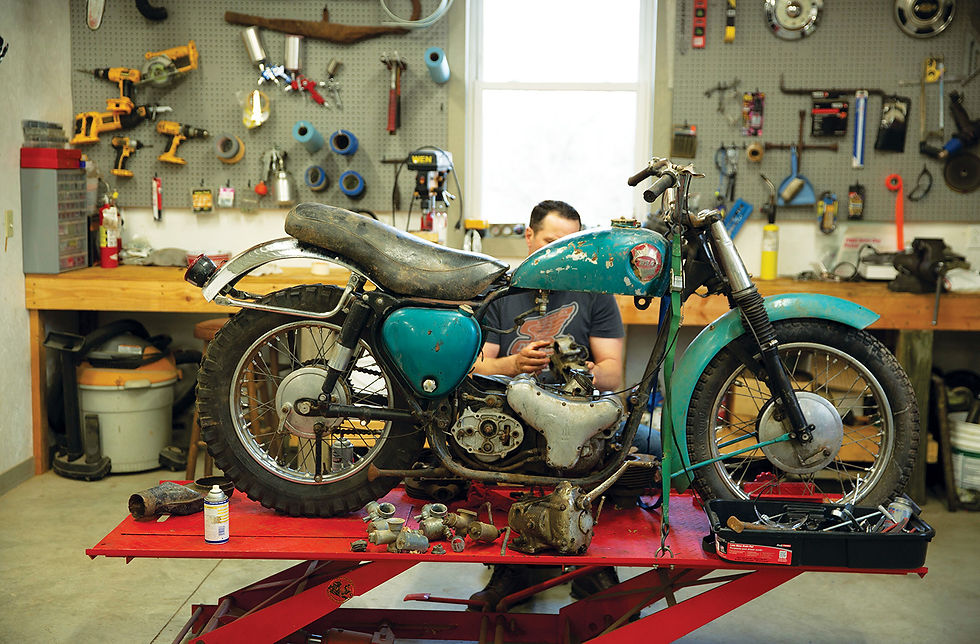In September of 2016, lighting struck. Keith, an avid motorcycle enthusiast and engineer at Boeing, hit the lottery of lotteries. Packed away in a dusty old barn in middle Missouri, a factory Harley-Davidson Motocross MX250 (#49) waited for years until the day the farmer’s son sold it to Keith.

It turned out there was much more to this find. The bike once belonged to Don "Killer" Kudalski (#49), the last rider to race for Harley-Davidson Motocross and the only rider to win a major AMA (American Motocyclist Association) race for the team. When Keith learned of the bike's pedigree, he began a journey of discovery into the forgotten history of the Harley-Davidson factory MX bike, the Harley-Davidson MX race program and the guys who took the ride with Harley between 1975 and 1978 into lightweight motocross history. So Keith restored the bike, researched its past, and wrote a book about his journey.
Meet Keith Geisner
My wife Sara and I grew up in Ste. Genevieve. We have been married for fourteen years. We have two children: our son, Rex, is four and a half years old, and our daughter, Eden, will turn three in March. I have been an engineer in the automotive and aviation industry for twenty years, and Sara is in public relations. We live in Festus.
I have lots of bikes ranging from parts bikes to preserved classics you can jump on and cruise down the road. My collection consists of on and off-road motorcycles from Japan, Europe and the United States. At last count, my inventory was around 100 motorcycles.
A 1986 Suzuki DR100 was my first bike.

My twin brothers Jeff and John had Suzuki DR125s—we tore up the surrounding farmland on these bikes for several years. My first important bike was a 1973 Honda CR250. This bike was Honda's first-ever CR sold to the public. After finding this bike and learning its significance in motorcycle history, the collecting bug started setting in. The 1977/78 Harley-Davidson MX Team bike #49 was my first discovered team bike, which ultimately led to my book.
I have the #319 Jim Simmons 1976 ISDT bike, too. I discovered this bike while I was finishing the preservation on the #49, and it will be the topic of my second book. I recently bought three vintage British BSAs. A 1952 A10 Plunger Golden Flash, 1958 A10 Super Rocket and 1960 A10 Spitfire Scrambler. I love old British bikes, and preserving these three will be a labor of love. Once finished, they'll join #49 and #319 as the elite bikes in my collection—maybe the topic of a third book?

From a young age, I was fascinated by anything with a motor. My parents Alan and Jan Geisner, owned and operated Al's Auto Body Inc. in Ste. Genevieve. My father's hobbies were drag racing and restoring classic cars. While he collected cars, my mom collected horses. They had a love of horsepower in common, and they passed their passion for hobbies on to me.
My hobby started innocently enough in, hearing my uncle's race stories and then getting my first dirt bike at the age of ten. Fast forward several years and I was riding and learning about different motorcycles in order to find the bike I liked most. During that time, I discovered I could make money buying motorcycles that needed some work, fixing it and selling it for a profit. This extra money supported my passion for motorcycles. I use that same business model today, keeping an eye out for motorcycles at a reasonable price. Lately, though, I stumble upon motorcycles when I'm not looking for any, and those usually end up being some exceptional motorcycles. It's pretty fitting—a friend recently told me that I didn't find a particular motorcycle, but rather the motorcycle found me.

I found the blue BSA with seven other bikes in Oklahoma. These are the most recent additions to my collection. I was after a 1973 ROKON, which will be one of the topics of my second book, but to get the ROKON I had to buy the whole lot of bikes. I view my motorcycle dealings like playing the card game rummy. In rummy, if you want a certain card on the discard pile, you have to take every card that's on top of the card you want. Usually this plays into your favor because those other cards are potential points for you as the game goes on. The American Pickers call this "bundling," but I came up with my rummy trick way before they were famous. Usually, these extra motorcycles I have to buy to secure the one I'm after get sold off, and I end up with the bike I wanted for little or no money out of pocket. That's true for a lot of the motorcycles in my collection.

In the case of the extra bikes I received with the ROKON, my game plan changed after I got the motorcycles home and found out what I had. There were three highly collectible BSA motorcycles in the lot, one of which was the blue 1960 BSA Spitfire Scrambler, one of only 267 produced in 1960. My plans for it are to find any missing pieces and preserve it back to original. I will get it running again and make it safe to ride. This could take a few years to do, but it will be a labor of love as I remove, examine, refurbish and reassemble every part. Preserving its current look while adding original correct parts is the plan. The look tells the story—it's what grabs people's attention.






Comments